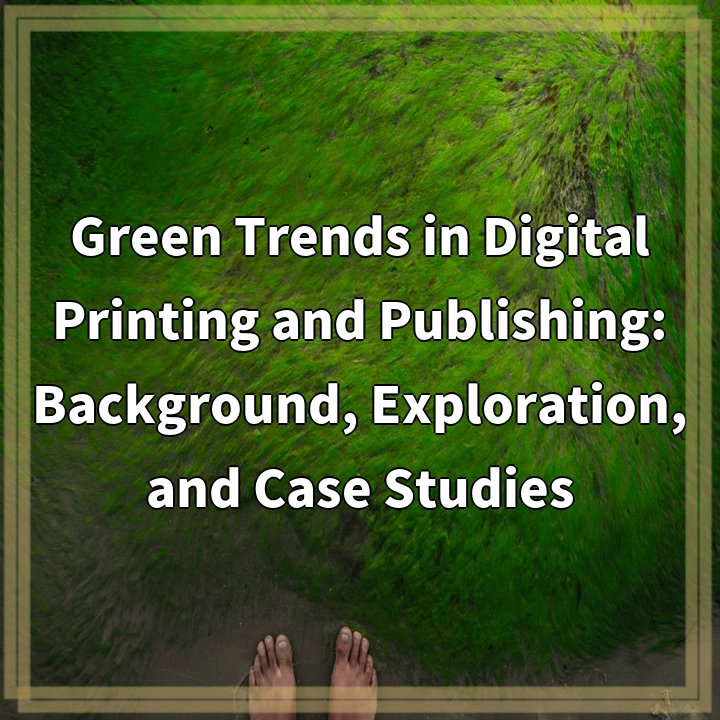
What is Green Trends in Digital Printing and Publishing?
Green trends in digital printing and publishing refer to the growing movement within the industry to adopt sustainable practices and reduce environmental impacts. With the increasing digitalization of content and the rise of online publishing platforms, there is a pressing need to address the environmental challenges posed by traditional printing and publishing methods.
Real-World Problems Associated with Green Trends in Digital Printing and Publishing
1. Deforestation and Resource Depletion
Traditional printing and publishing heavily rely on paper, leading to deforestation and the depletion of natural resources. Large quantities of trees are cut down to produce the paper needed for books, magazines, and other printed materials. This has a devastating impact on ecosystems, contributing to habitat loss, soil erosion, and climate change.
2. Air and Water Pollution
Conventional printing processes often involve the use of inks, solvents, and chemicals that release harmful pollutants into the air and water systems. The manufacturing and disposal of printing equipment also contribute to pollution. These pollutants can have detrimental effects on human health as well as ecosystem health, with implications for biodiversity and water quality.
3. Waste Generation and Landfill Contribution
Traditional printing and publishing generate significant amounts of waste, including unused or outdated materials, excess paper, and printing plates. Much of this waste ends up in landfills, contributing to the already mounting waste management problem globally. This waste not only takes up valuable space but also contributes to the release of greenhouse gases as it decomposes.
4. Carbon Footprint and Energy Consumption
The energy-intensive nature of traditional printing processes, as well as the transportation and distribution of printed materials, contributes to a large carbon footprint. Printing presses, drying systems, and other machinery consume substantial amounts of energy. Additionally, the transport of printed materials over long distances further worsens the environmental impact.
5. Limited Accessibility and Diversity
The traditional publishing industry often has barriers to entry, limiting the voices and perspectives that are represented in printed materials. This lack of diversity can perpetuate inequalities and restrict access to knowledge and information for marginalized communities. By embracing digital publishing, there is an opportunity to overcome some of these barriers, making information more accessible and diverse.

Solutions to Green Trends in Digital Printing and Publishing
1. Sustainable Paper and Materials
One solution is to utilize sustainable paper sources, such as recycled or FSC-certified paper. Additionally, exploring alternatives to paper, such as digital reading devices, electronic publications, and online platforms, can significantly reduce the reliance on paper and minimize deforestation and resource depletion.
2. Environmentally-Friendly Inks and Printing Technologies
Transitioning to eco-friendly inks, such as vegetable-based or soy-based inks, can significantly reduce air and water pollution. Investing in advanced printing technologies that minimize the use of chemicals and solvents, as well as adopting digital printing methods that require fewer resources, can further reduce environmental impacts.
3. Waste Reduction and Recycling
Implementing waste reduction strategies, such as print-on-demand approaches and optimizing print production, can minimize the amount of excess or unused materials generated. Establishing proper recycling programs for paper, printing equipment, and other related materials can also help divert waste from landfills and promote a circular economy within the industry.
4. Energy Efficiency and Carbon Offsetting
Promoting energy-efficient practices in printing facilities, such as using energy-saving machinery and optimizing printing processes, can reduce the carbon footprint. Additionally, investing in renewable energy sources like solar or wind power can help offset the energy consumption associated with digital printing and publishing operations.
5. Embracing Inclusive and Diverse Digital Publishing
Digital publishing platforms provide opportunities for greater inclusivity and diversity. By supporting and amplifying diverse voices and perspectives, digital publishers can contribute to a more equitable and accessible dissemination of information. This can be achieved by actively seeking out and promoting content from marginalized communities and ensuring accessibility features for individuals with disabilities.















